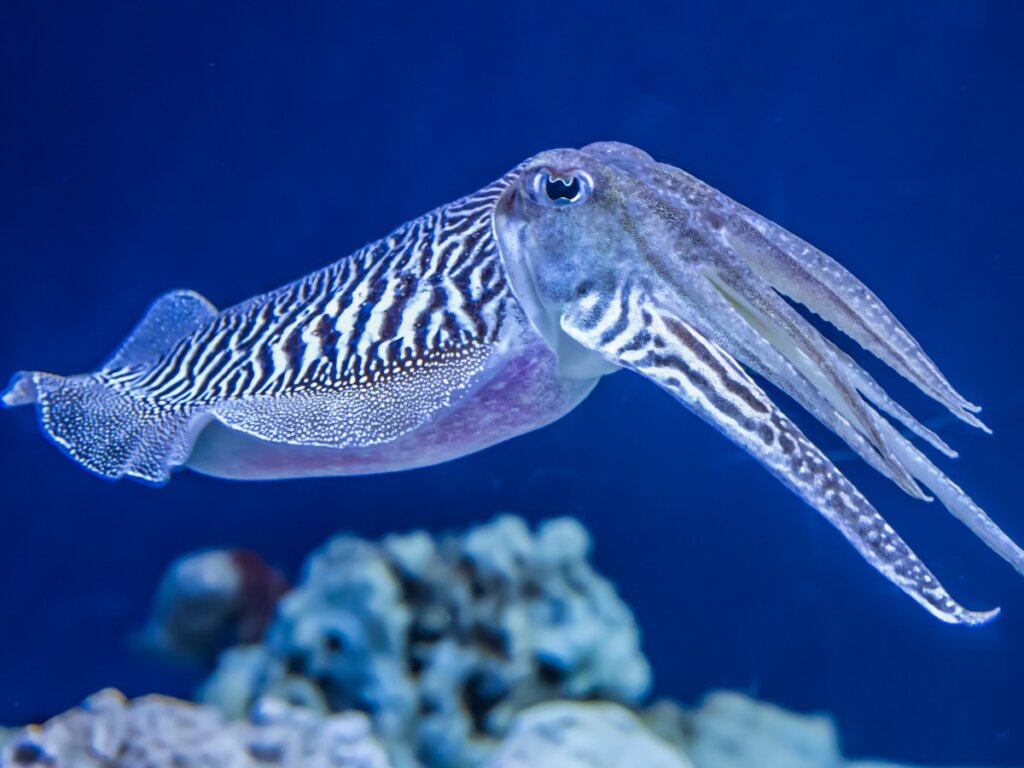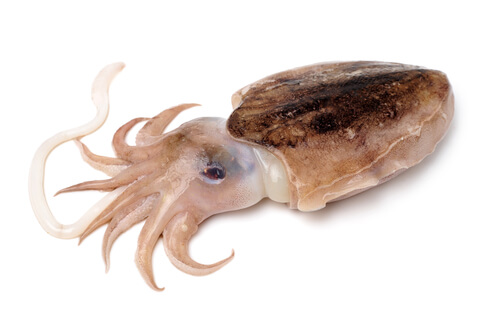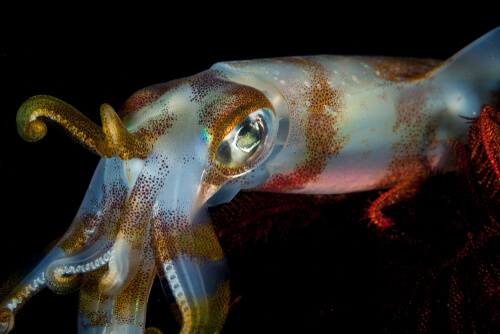9 Curiosities About Cuttlefish

Cephalopods are much more interesting to study than to eat! If you don’t believe it, it’s because you haven’t read all our curiosities about cuttlefish yet! They’re amazing animals, and seem like something out of a fiction novel because of all their unique characteristics.
Cuttlefish are cephalopod mollusks whose main characteristic is that they have a hard inner shell. Let’s get to know them a bit better in the following lines.
Cuttlefish characteristics
As mentioned before, the cuttlefish is a cephalopod mollusk that belongs to the genus Sepiida. All species have 8 arms and 2 retractile tentacles that they use to capture their prey. The suction disks are located on the arms and on the tips of the tentacles.
Like its close relatives, such as the octopus, it’s able to produce ink that it will eject to help it escape in case of danger.
It inhabits all the world’s oceans, but is usually found in temperate and tropical waters. There’s a great variety: some live in deep waters, some are solitary, and others swim in schools, etc.
As for its diet, it’s a strictly carnivorous animal. They usually feed on small mollusks and fish that they find in their environment. To catch them, they usually camouflage themselves on a surface and wait to ambush their prey by trapping it with their tentacles. Cuttlefish are also preyed upon and their hunters include dolphins, sharks, seals, and even other cuttlefish.
Curiosities about the cuttlefish

If you just look at it on the outside, you probably won’t appreciate its incredible characteristics. So, don’t go away! Keep reading and find some curiosities about cuttlefish that will help you understand just how special they are.
1. The cuttlefish doesn’t swim, it just floats
The rigidity of its inner shell doesn’t allow it to perform swimming movements, so it usually takes advantage of its buoyancy to move, as well as using underwater currents, balancing with its fin. It also expels water through its siphon to propel itself.
2. They change the color spectrum of their eyesight
It was originally believed that octopuses and their marine cousins don’t detect colors, but only polarized light. However, a study revealed that they actually change their visible color spectrum to adapt to the depth at which they swim.
3. They have three hearts
Since the gills need constant and rapid irrigation, cuttlefish and other cephalopods have three hearts. Two of them, called gill hearts, are in charge of irrigating this part of their respiratory apparatus. On the other hand, the systemic heart distributes the oxygenated blood coming from the gills throughout the rest of the body.
4. Their blood is blue
Cephalopods are such noble specimens that they have blue blood! While in mammals it’s hemoglobin that transports oxygen, in the case of cuttlefish and other mollusks it’s hemocyanin.
This molecule dissolves in the plasma, which gives the blood a very characteristic blue-green color. Thanks to hemocyanin, cuttlefish are able to properly oxygenate their bodies in cold water with blood that’s much thicker than normal.
5. Master of camouflage
Another of the cuttlefish’s curiosities is its ability to change color at will. Its skin is covered with cells called chromatophores, thanks to which the cuttlefish can influence the light it reflects to create one color or another.
This not only serves a camouflage function, but also influences areas such as communication or the search for a breeding partner.
6. Its pupil is W-shaped
This unique formation of the cuttlefish’s pupil is due to the need to detect contrasts, rather than colors, especially in marine depths where light is scarce. In addition, their light-receiving cells are concentrated at two points, one to focus forward and one to cover the back.
7. Females die caring for eggs
Mothers of species such as cuttlefish, octopus, and other cephalopods are known for the incredible sacrifice they make to ensure the survival of their offspring. Once the female is fertilized, she’ll lay her eggs in a remote, quiet place. There she’ll stand guard without eating until the eggs hatch, at which point she dies.
8. They change the shape of their eyes
This, although it may sound rather farfetched, should serve as a reminder that we mammals are also capable of it. However, while what changes in us is the shape of the lens (which is located inside the eyeball), cuttlefish change the shape of their entire eye in order to focus.
9. Their nervous system is complex and peculiar
It’s difficult to talk about the cephalopods’ nervous system in a simplified way, because it’s so complex and different from that of a mammal that it’s difficult to understand exactly how it works. Their brains are divided into 2 areas and covered by a cartilaginous mass that serves as a skull.
Cephalopods have the most complex central nervous system out of all invertebrates.
A new study has revealed previously unknown neural networks in charge of visually guided behaviors. For example, they can camouflage themselves only from above or below if they know that something is watching them in that area.

Had you heard about all these curiosities about cuttlefish? The more you investigate, the more surprised you’ll be about what you find. For this reason, we encourage you to keep up to date with the new findings being made about cuttlefish. You can be sure that cuttlefish will continue to surprise humans for a long time to come.
All cited sources were thoroughly reviewed by our team to ensure their quality, reliability, currency, and validity. The bibliography of this article was considered reliable and of academic or scientific accuracy.
- Chung, W. S., & Marshall, N. J. (2016). Comparative visual ecology of cephalopods from different habitats. Proceedings of the Royal Society B: Biological Sciences, 283(1838), 20161346.
- Feord, R. C., Sumner, M. E., Pusdekar, S., Kalra, L., Gonzalez-Bellido, P. T., & Wardill, T. J. (2020). Cuttlefish use stereopsis to strike at prey. Science advances, 6(2), eaay6036.
- Chung, W. S., Kurniawan, N. D., & Marshall, N. J. (2020). Toward an MRI-based mesoscale connectome of the squid brain. Iscience, 23(1), 100816.